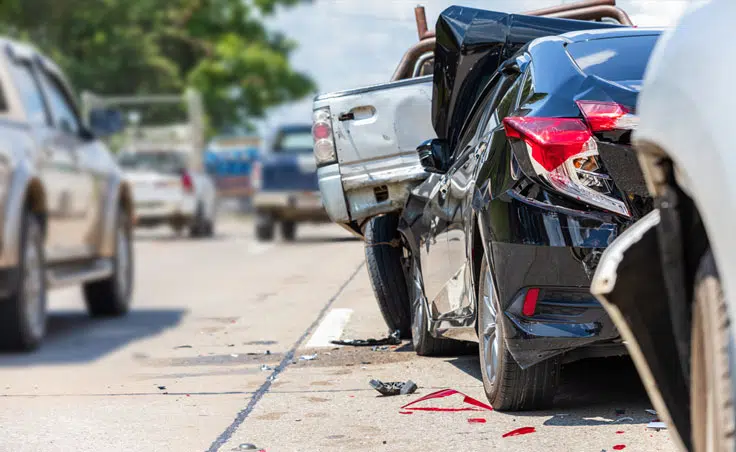Were you in a car accident involving several vehicles? Here’s what to expect moving forward with your claim.

Car accidents involving multiple vehicles are not always as straight forward as they may seem. Liability can often be complicated, and unless you act quickly, you could be left in the cold when it comes to compensation.
While it may seem like a minor issue on the surface, any accident involving more than two vehicles can result in a complex web of overlapping insurance policies, severely-delayed claims, and a smaller pool of money available to compensate the victims for their losses. As a personal injury law firm which handles these kinds of car wrecks on a daily basis, we wanted to discuss the how they’re different, and share some facts that we feel everyone should know.
Fault & Liability in a Multi-Vehicle Accident
When it comes to any car accident involving more than two vehicles, determining liability is not always as simple as it may seem. Even in cases where fault is obvious or even uncontested, more than one driver may still share in liability. For example, let’s say traffic was slowing down due to road construction or a previous accident and an inattentive driver slams into the rear of the vehicle in front of them. As a result, the car that was hit rear-ends the car ahead of them, and that car then rear-ends the vehicle in front of them, and so fourth.
Let’s imagine that you were driving one of the vehicles in the middle of the crash (i.e., you got rear-ended and pushed into the car in front of you). The inattentive driver is obviously at fault for the crash, but depending on the circumstances, the insurance company may determine that the driver behind you was partially labile (comparatively negligent) for failing to keep a safe following distance. On that note, you yourself may also be found partially liable to the vehicle in front of you for the same reason.
In accidents where fault is less clear and/or you have conflicting accounts from multiple drivers, it may be several months until fault and liability are determined. Without an attorney helping you with your claim, you’re unfortunately at the mercy of the insurance company. They’re in no rush to offer you a fair settlement, and they’ll look for any reason to deflect blame or contest the value of your claim.
Policy Limits & The Importance of Acting Quickly
Texas requires every driver to carry a liability auto insurance policy with at least “30/60/25” coverage. This means that the policy will pay out a maximum of $25,000 in property damage for each accident, and a maximum of $60,000 in bodily injury damages per accident (with a maximum of $30,000 per person). While some drivers may have higher limits than this, the vast majority of drivers in Texas carry 30/60/25 policies.
$25,000 in property damage coverage is usually sufficient for most “common” car accident claims (i.e., low-speed collisions involving two vehicles), but the same cannot be said for accidents involving several vehicles. Let’s take the same accident example from earlier in this article. Say the first car that was rear ended was totaled out ($25,000 in property damages). The second car sustained $10,500 in damages, your car sustained $6,000 in damages, and the car in front of you sustained $3,000 in damages. We know the insurance company isn’t paying a penny more than $25,000 total in property damages, so how is the money divided? It’s literally first come, first served. If the driver of the totaled vehicle settles their claim before you do, you may never see a single penny in compensation.
If injuries are involved, it’s the same exact deal. The insurance company is only on the hook for a maximum of $60,000 in bodily injury coverage per accident — and only if their driver is 100% liable. Injuries are common in car wrecks, and medical bills aren’t cheap. Once policy limits have been exhausted, all the other victims are essentially locked out when it comes to compensation. This is why it’s always important to speak with an attorney as soon as possible after being injured in a wreck — especially if there are several vehicles involved.
Important Steps to Take Following a Pileup Accident
- Stay in your car (unless obviously unsafe), call emergency services, and wait for first responders to arrive.
- If possible, request a crash report number from the police and take pictures of the accident scene. Collect the contact and insurance information of all drivers involved in the crash. If anyone witnessed the crash, collect his or her information as well.
- If you were injured, seek medical attention as soon as possible! If you cannot afford a doctor out of pocket, speak to a personal injury attorney about a “letter of protection.”
- Report the accident to either your insurance company, or to a personal injury attorney (who will then file a claim on your behalf).
When it comes to car accidents involving multiple vehicles, the most important thing is to act quickly. If you’re injured, speak to an attorney as soon as possible. It costs nothing out of pocket to have a a firm like ours handle your entire claim from beginning to end, and we’ll hold their feet to the fire. We have considerable experience with pileups and multi-car accidents, and consultations are always free.
If you have questions or would like to discuss your case with the Dallas car accident lawyers at Montgomery Law, call us today at 214-720-6090 (local) or 1-833-720-6090 (toll-free). Alternatively, you can shoot us a quick email or chat with us online!

Montgomery Law is a Dallas-based personal injury law firm focused on getting clients the justice and compensation they deserve.
Call us toll-free at 1-833-720-6090 to discuss your case today for no cost.


Leave A Comment